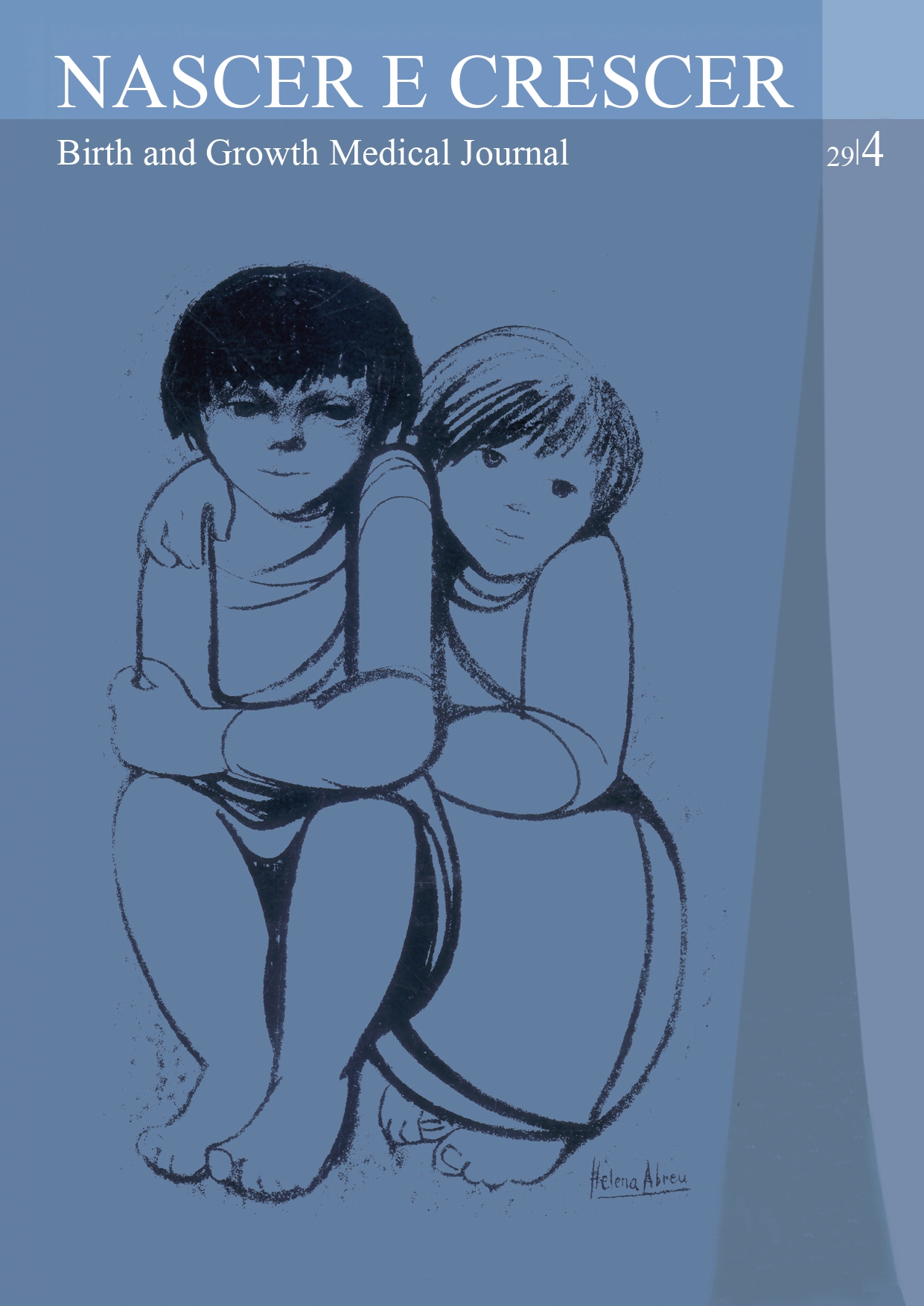Unintentional injuries and associated factors among adolescents
DOI:
https://doi.org/10.25753/BirthGrowthMJ.v29.i4.18455Keywords:
accident prevention, adolescent medicine, unintentional injuriesAbstract
Introduction: Unintentional injuries are an important cause of death in adolescents, as well as a major cause of ill health. This age group is prone to unintentional injuries due to their specific biological, psychological, and social characteristics. To prevent these injuries, it is crucial to understand their prevalence and associated factors. The aim of this study was to identify and characterize unintentional injuries in adolescents and their potential impact on health and life.
Material and Methods: Prospective, observational, two-center study over one year based on a survey of adolescents admitted to the Emergency Department due to unintentional injuries.
Results: The study included 1054 adolescents (840 from Center A and 214 from Center B), mostly male (58.2%), 51.6% of which in early adolescence (10 to 13 years old) and only 11.2% in late adolescence (17 to 18 years old). Alchool or drug use were reported by 2.3% of participants. Main reported injuries included traumatic injuries (mainly during sports), accidental falls (mainly at school), and road traffic accidents (being run over by a car as the most frequent). Acidental falls and traumatic injuries were more common in early adolescence, whereas burns, road traffic accidents, and intoxications were more frequent in middle adolescence. Low frequency of personal protection equipment use (31.3%) was reported by bycicle riders. School absence was reported in 31% of cases, mainly associated with traumatic injuries (49.8%) and falls (40.1%).
Conclusion: Most reported unintentional injuries had preventable causes and their prevalence was developmental stage-dependent. These results provide additional data for implementation of preventive measures according to developmental adolescence stages.
Downloads
References
Child and adolescent injury prevention: a global call to action. Geneva, World Health Organization and UNICEF, 2005. (https://apps.who.int/iris/handle/10665/43279, accessed 21 January 2015).
Child and adolescent injury prevention: a WHO plan of action. Geneva, World Health Organization, 2006. (https://apps.who.int/iris/handle/10665/43267,accessed 21 January 2015).
World report on child injury prevention. Geneva. World Health Organization, 2008. (https://www.who.int/violence_injury_prevention/child/injury/world_report/en/, accessed 21 January 2015).
Holland-Hall C, Burstein GR, Bockting WO, Adelson SL, Schuster MA. Chapter 110 Adolescent Development. In: Kliegman RM, Stanton BF, St Geme JW, Schor NF, Behrman RE, editors; Nelson Textbook of Pediatrics; 20th edition, Philadelphia, Elsevier, 2015; 926.
Burstein GR. The Epidemiology of adolescente Health Problems. In: Kliegman R. M, Stanton BF, St Geme JW, Schor NF, Behrman RE, editors; Nelson Textbook of Pediatrics; 20thedition, Philadelphia, Elsevier, 2015;937.
Alonso-Fernández N, Jiménez-García R, Alonso-Fernández L, Hernández-Barrera V, Palacios-Ceña D. Unintentional injuries and associated factors among children and adolescents. An analysis of the Spanish National Health Survey. Int J Public Health. 2017; 62: 961–9.
Gicquel L, Ordonneau P, Blot E, Toillon C, Ingrand P, Romo L. Description of Various Factors Contributing to Traffic Accidents in Youth and Measures Proposed to Alleviate Recurrence. 2017. Front. Psychiatry 8:94.
Global Accelerated Action for the Health of Adolescents (AA-HA!): guidance to support country implementation. Geneva: World Health Organizaton; 2017 (https://www.who.int/maternal_child_adolescent/topics/adolescence/framework-accelerated-action/en/. Accessed January 2019).
Injury surveillance guidelines. Geneva. World Health Organization, 2011 (http://www.who.int/violence_injury_prevention/media/en/136.pdf. Accessed October 2017).
Salam RA, Arshad A, Das JK, Khan MN, Mahmood W, Freedman SB, Bhutta ZA. Interventions to prevent unintentional injuries among adolescents: a systematic review and meta-analysis. J Adolesc Health. 2016; 59:S76–87.
Global status report on road safety 2018: summary. Geneva. World Health Organization.2018. (https://www.who.int/violence_injury_prevention/road_safety_status/2018/English-Summary-GSRRS2018.pdf. Accessed January 2019).
Fonseca P, Seixas D, Fonseca H, Brandão S, Fontoura M. Brain Magnetic Resonance evaluation and pubertal development variations among female adolescents. Nascer e Crescer – Birth and Growth Medical Journal. 2017; 26: 36-42.
Hazen E, Schlozman S, Beresin E. Adolescent Psychological Development: A review. Pediatr Rev 2008; 29:161-8.
Romer D. Adolescent risk taking, impulsivity and brain development: Implications for prevention. Dev Psychobiol. 2010; 52:263-76.
Blakmore SJ, Burnett S, Dahl RE. The role of puberty in the developing adolescent brain. Hum Brain Mapp 2010; 31:926-33.
Jonhson SB, Blum R, Giedd J. Adolescent Maturity and the Brain: The promise and Pitfalls of Neuroscience Research in Adolescent Health Policy. J Adolesc Health 2009; 45:216-21.
Blakemore SJ. The social brain in adolescence. Nature Rev Neurosci. 2008; 9:267-77.
Giedd JN. The Teen Brain: Insights from Neuroimaging. J Adolesc Health 2008; 42:335-43.
Giedd JN, Stockman M, Weddle C, Liverpool M, Alexander-Bloch A, Wallace GL, et al. Anatomic magnetic resonance imaging of developing and adolescent brain and effects of genetic variation. Neuropsychol Rev 2010; 20:349-61.
Luna B, Padmanabhan A, O’Hearn K. What has fMRI told us about the development of cognitive control through adolescence? Brain Cogn 2010; 72:101-13.
Paton GC, Sawyer SM, Santelli JS, Ross DA, Aff R, Allen NB, et al. Our future: a Lancet commission on adolescente health and wellbeing. Lancet. 2016; 387:2423-78. (http://www.thelancet.com/journals/lancet/artcle/PIIS0140-6736(16)00579-1/fulltext. Accessed October 2017).
Stenberg K, Axelson H, Sheehan P, Anderson I, Gülmezoglu AM, Temmerman M. et al. Advancing social and economic development by investng in women’s and children’s health: a new global investment framework. Lancet. 2014; 383:1333-54. (htp://www.sciencedirect.com/science/artcle/pii/S014067361362231X.Accessed October 2017).
UNFPA. The case for investing in young people as part of a national poverty reduction strategy. New York; 2010. (htp://www.unfpa.org/publicatons/case-investng-young-people. Accessed October 2017).
World Bank. World development report 2007: development and the next generaton. Washington DC; 2007. (http://documents.worldbank.org/curated/en/556251468128407787/pdf/359990WDR0complete.pdf. Accessed October 2017).
Orton E, Whitehead J, Mhizha-Murira J, Clarkson M, Watson MC, Mulvaney CA, et al. School-based education programmes for the prevention of unintentional injuries in children and young people (Review). Cochrane Database of Systematic Reviews 2016; 12:CD010246.
Herbert A, Gilbert R, Cottrell D, Li L. Causes of death up to 10 years after admissions to hospitals for self-inflicted, drug-related or alcohol-related, or violent injury during adolescence: a retrospective, nationwide, cohort study. Lancet. 2017; 390:577-87.
Downloads
Published
How to Cite
Issue
Section
License
Copyright and access
This journal offers immediate free access to its content, following the principle that providing free scientific knowledge to the public provides greater global democratization of knowledge.
The works are licensed under a Creative Commons Attribution Non-commercial 4.0 International license.
Nascer e Crescer – Birth and Growth Medical Journal do not charge any submission or processing fee to the articles submitted.


